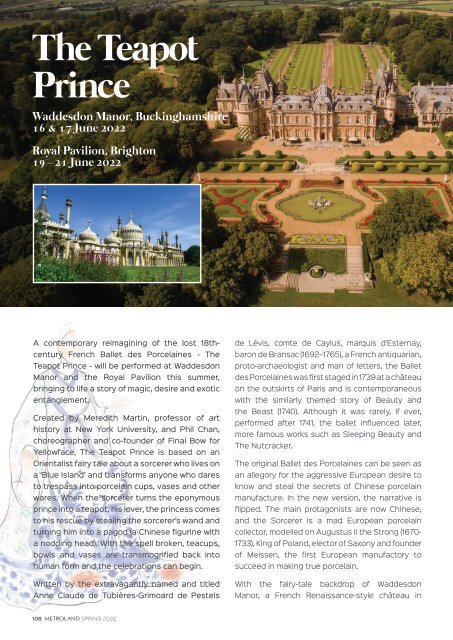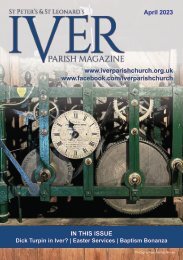METROLAND Spring 2022
Metroland Magazine is written by the community for the community with our own unique design. Covering life in Chesham, Amersham and Chalfont bringing you the best places to dine, days out, high street businesses, charities and projects.
Metroland Magazine is written by the community for the community with our own unique design. Covering life in Chesham, Amersham and Chalfont bringing you the best places to dine, days out, high street businesses, charities and projects.
Create successful ePaper yourself
Turn your PDF publications into a flip-book with our unique Google optimized e-Paper software.
The Teapot<br />
Prince<br />
Waddesdon Manor, Buckinghamshire<br />
16 & 17 June <strong>2022</strong><br />
Royal Pavilion, Brighton<br />
19–21 June <strong>2022</strong><br />
A contemporary reimagining of the lost 18thcentury<br />
French Ballet des Porcelaines - The<br />
Teapot Prince - will be performed at Waddesdon<br />
Manor and the Royal Pavilion this summer,<br />
bringing to life a story of magic, desire and exotic<br />
entanglement.<br />
Created by Meredith Martin, professor of art<br />
history at New York University, and Phil Chan,<br />
choreographer and co-founder of Final Bow for<br />
Yellowface, The Teapot Prince is based on an<br />
Orientalist fairy tale about a sorcerer who lives on<br />
a ‘Blue Island’ and transforms anyone who dares<br />
to trespass into porcelain cups, vases and other<br />
wares. When the sorcerer turns the eponymous<br />
prince into a teapot, his lover, the princess comes<br />
to his rescue by stealing the sorcerer’s wand and<br />
turning him into a pagod (a Chinese figurine with<br />
a nodding head). With the spell broken, teacups,<br />
bowls and vases are transmogrified back into<br />
human form and the celebrations can begin.<br />
Written by the extravagantly named and titled<br />
Anne Claude de Tubières-Grimoard de Pestels<br />
de Lévis, comte de Caylus, marquis d'Esternay,<br />
baron de Bransac (1692–1765), a French antiquarian,<br />
proto-archaeologist and man of letters, the Ballet<br />
des Porcelaines was first staged in 1739 at a château<br />
on the outskirts of Paris and is contemporaneous<br />
with the similarly themed story of Beauty and<br />
the Beast (1740). Although it was rarely, if ever,<br />
performed after 1741, the ballet influenced later,<br />
more famous works such as Sleeping Beauty and<br />
The Nutcracker.<br />
The original Ballet des Porcelaines can be seen as<br />
an allegory for the aggressive European desire to<br />
know and steal the secrets of Chinese porcelain<br />
manufacture. In the new version, the narrative is<br />
flipped. The main protagonists are now Chinese,<br />
and the Sorcerer is a mad European porcelain<br />
collector, modelled on Augustus II the Strong (1670-<br />
1733), King of Poland, elector of Saxony and founder<br />
of Meissen, the first European manufactory to<br />
succeed in making true porcelain.<br />
With the fairy-tale backdrop of Waddesdon<br />
Manor, a French Renaissance-style château in<br />
108 <strong>METROLAND</strong> SPRING <strong>2022</strong> <strong>METROLAND</strong> MAGAZINE WINTER 2021


















